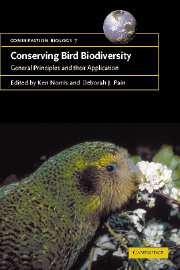Book contents
- Frontmatter
- Contents
- List of contributors
- Preface
- 1 Biodiversity – evolution, species, genes
- 2 Why conserve bird diversity?
- 3 Mapping and monitoring bird populations: their conservation uses
- 4 Priority-setting in species conservation
- 5 Selecting sites for conservation
- 6 Critically endangered bird populations and their management
- 7 Diagnosing causes of population declines and selecting remedial actions
- 8 Outside the reserve: pandemic threats to bird biodiversity
- 9 Predicting the impact of environmental change
- 10 Fragmentation, habitat loss and landscape management
- 11 The interface between research, education and training
- 12 Conservation policies and programmes affecting birds
- References
- Index
4 - Priority-setting in species conservation
Published online by Cambridge University Press: 10 December 2009
- Frontmatter
- Contents
- List of contributors
- Preface
- 1 Biodiversity – evolution, species, genes
- 2 Why conserve bird diversity?
- 3 Mapping and monitoring bird populations: their conservation uses
- 4 Priority-setting in species conservation
- 5 Selecting sites for conservation
- 6 Critically endangered bird populations and their management
- 7 Diagnosing causes of population declines and selecting remedial actions
- 8 Outside the reserve: pandemic threats to bird biodiversity
- 9 Predicting the impact of environmental change
- 10 Fragmentation, habitat loss and landscape management
- 11 The interface between research, education and training
- 12 Conservation policies and programmes affecting birds
- References
- Index
Summary
INTRODUCTION
Problems in the environment are recognised long in advance of solutions; and since money tends to be parted with only when compelling evidence of an effective solution is presented, it is an inevitable circumstance – or at least perception – that the resources available for conservation are always fewer than the number of issues for which they are judged to be needed. It follows that priorities have to be set.
The move towards setting priorities in conservation began with formal initiatives to record and rank species threatened with extinction. Red Data Books, which undertook this documentation, were first produced within IUCN in the early 1960s (Scott et al. 1987). Over the ensuing 30 years the IUCN Red Data Book programme, except for birds, was regrettably replaced by a simple Red List (Collar 1996), although Red Data Books have continued to be central to planning at national levels, and the proliferation of such books in the past 30 years has been remarkable (Burton 1984; hence Gärdenfors et al. 1999). Since conservation actions directed at species are nearly always directed at their habitats, a logical consequence was the rapid growth in priority-setting systems directed at areas. One simple and cost-effective solution was to identify key areas of overlap between threatened species (Collar & Stuart 1988; Wege & Long 1995). However, the paucity of high-resolution distribution data for species other than birds has limited this approach and much attention has been afforded to the development and use of indicator or surrogate measures (see Chapter 5).
- Type
- Chapter
- Information
- Conserving Bird BiodiversityGeneral Principles and their Application, pp. 61 - 73Publisher: Cambridge University PressPrint publication year: 2002
- 11
- Cited by

